Java操作Redis Java中操作Redis的详细方法
利威尔兵短 人气:0想了解Java中操作Redis的详细方法的相关内容吗,利威尔兵短在本文为您仔细讲解Java操作Redis的相关知识和一些Code实例,欢迎阅读和指正,我们先划重点:Java操作Redis,下面大家一起来学习吧。
1.准备操作
1.1 新建工程

1.2 sca-jedis工程依赖
<dependencies>
<dependency>
<groupId>redis.clients</groupId>
<artifactId>jedis</artifactId>
<version>3.5.2</version>
</dependency>
<dependency>
<groupId>junit</groupId>
<artifactId>junit</artifactId>
<version>4.12</version>
<scope>test</scope>
</dependency>
<dependency>
<groupId>com.google.code.gson</groupId>
<artifactId>gson</artifactId>
<version>2.8.6</version>
</dependency>
</dependencies>
1.3 sca-tempalte工程依赖
<dependencyManagement>
<dependencies>
<dependency>
<groupId>org.springframework.boot</groupId>
<artifactId>spring-boot-dependencies</artifactId>
<version>2.3.2.RELEASE</version>
<scope>import</scope>
<type>pom</type>
</dependency>
</dependencies>
</dependencyManagement>
<dependencies>
<dependency>
<groupId>org.springframework.boot</groupId>
<artifactId>spring-boot-starter-web</artifactId>
</dependency>
<dependency>
<groupId>org.springframework.boot</groupId>
<artifactId>spring-boot-starter-data-redis</artifactId>
</dependency>
<dependency>
<groupId>org.springframework.boot</groupId>
<artifactId>spring-boot-starter-test</artifactId>
<scope>test</scope>
</dependency>
</dependencies>
1.4 测试是否可以连接Redis
package com.jt;
import org.junit.Test;
import redis.clients.jedis.Jedis;
public class JedisTests {
@Test
public void testGetConnection(){
//假如不能连通,要注释掉redis.conf中 bind 127.0.0.1,
//并将protected-mode的值修改为no,然后重启redis再试
Jedis jedis=new Jedis("192.168.126.129",6379);
//jedis.auth("123456");//假如在redis.conf中设置了密码
String ping = jedis.ping();
System.out.println(ping);
}
}
测试结果
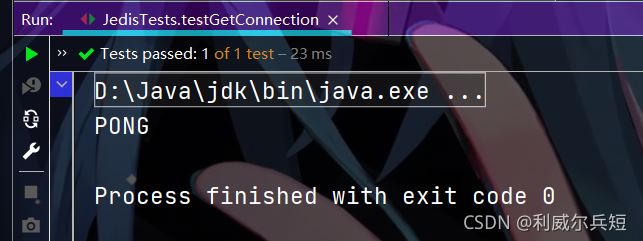
注意保持一致:
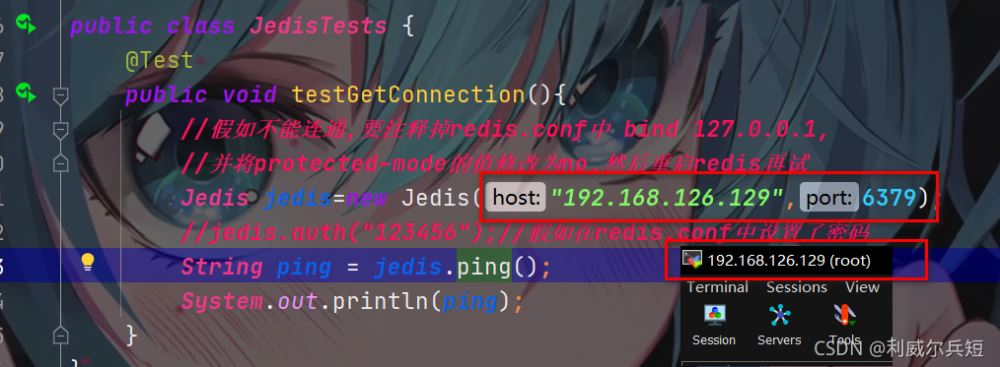
1.5 修改redis.conf文件
/usr/local/docker/redis01/conf/目录下
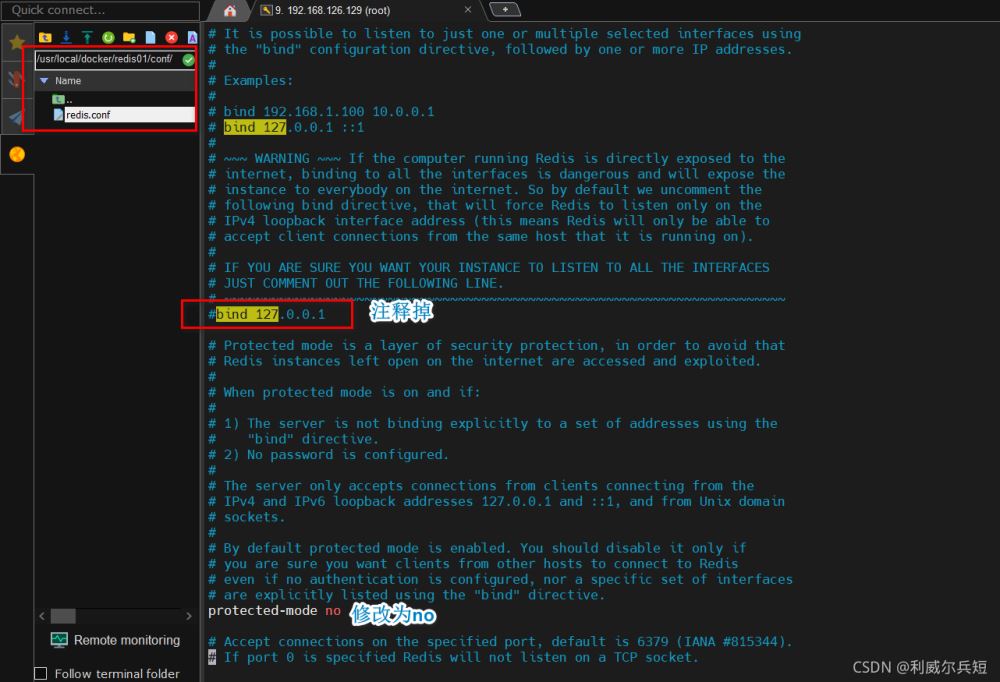
修改配置文件之后需要重启,然后再测试连接 拓展:设定编译版本


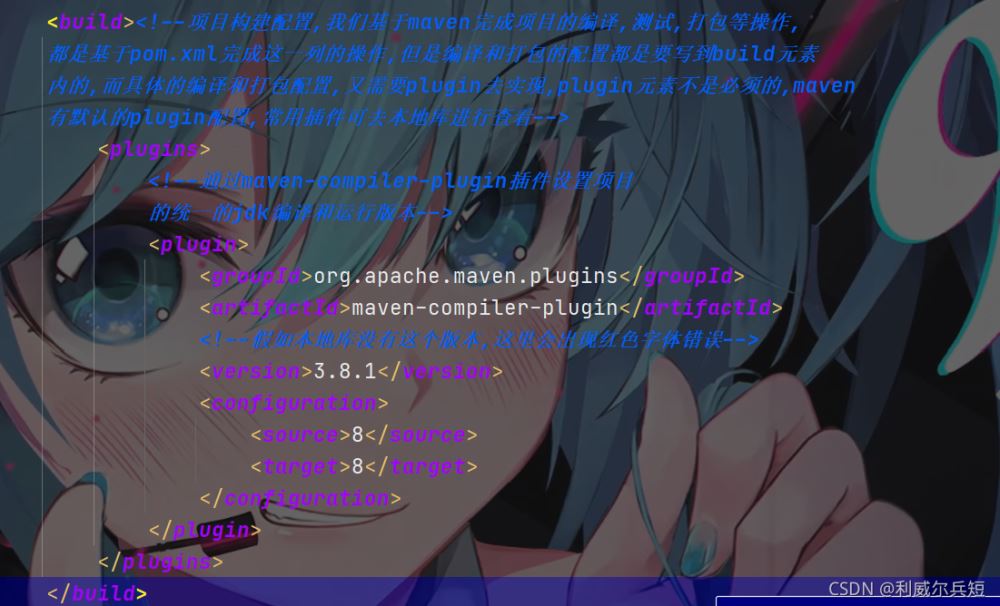
2. 基于Jedis实现对redis中字符串的操作
@Test
public void testString01(){
//1.创建连接对象
Jedis jedis=new Jedis(ip,port);
//2.执行redis读写操作
//2.1想redis中存储字符串数据
jedis.set("id", "100");
jedis.expire("id", 2);
jedis.set("token", UUID.randomUUID().toString());
jedis.incr("id");
Map<String,Object> map=new HashMap<>();
map.put("code", "201");
map.put("name", "redis");
Gson gson=new Gson();
String jsonStr = gson.toJson(map);//将map对象转换为json字符串
jedis.set("lession",jsonStr);
//2.2删除数据
jedis.del("id");
//2.3获取数据
String id=jedis.get("id");
jsonStr=jedis.get("lession");
System.out.println(id);
System.out.println(jsonStr);
//3.释放资源
jedis.close();
}
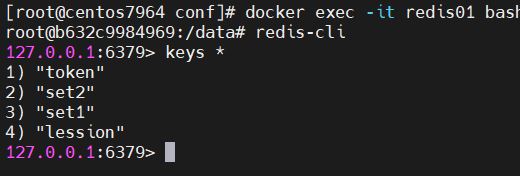
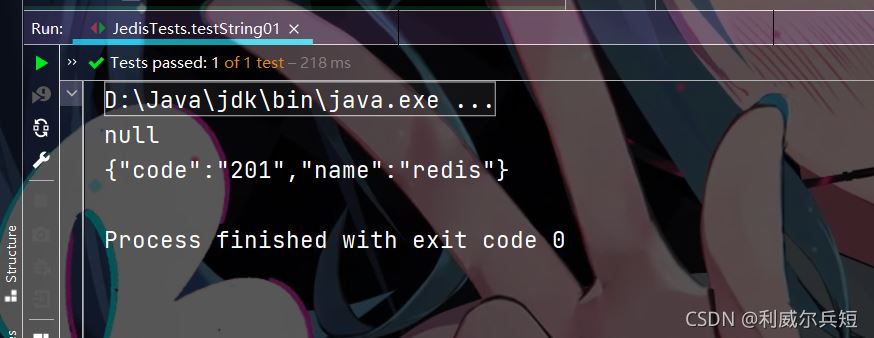
3. 模式总结
==享元模式:==设计思想,通过池减少对象的创建次数,实现对象的可重用性,所有池的设计都有这个设计模式的应用
=例如整数池、字符串池、线程池、连接池
- AOP 代理模式
- Singleton 单例 HikariPool
- xxxAdapter 适配器模式
- Ribbon 策略
- RestTemplate 模板方法模式
- SL4J 门面
- Interceptor 执行链模式
- 工厂模式
4. 连接池JedisPool应用
package com.jt;
import org.junit. Test;
import redis.clients.jedis.Jedis;
import redis.clients.jedis.JedisPool;
import redis.clients.jedis.JedisPoolConfig;
/*享元模式:设计思想,通过池减少对象的创建次数,实现对象的可重用性,所有池的设计都有这个设计模式的应用
* 例如整数池、字符串池、线程池、连接池
* Jedis连接池(与redis数据库的连接)
* */
public class JedisPoolTests {
@Test
public void testJedisPool(){
//定义连接池配置
JedisPoolConfig config=new JedisPoolConfig();
//最大连接数
config.setMaxTotal(1000);
//最大空闲时间
config.setMaxIdle(60);
//创建连接池
JedisPool jedisPool=new JedisPool(config,"192.168.126.129",6379);
//从池中获取一个连接
Jedis resource = jedisPool.getResource();
//通过redis连接获取数据
resource.set("class", "cgb2107");
String aClass = resource.get("class");
System.out.println(aClass);
//释放资源
resource.close();//把连接还回去
jedisPool.close();
}
}
连接池配置也可以不写,因为有默认的
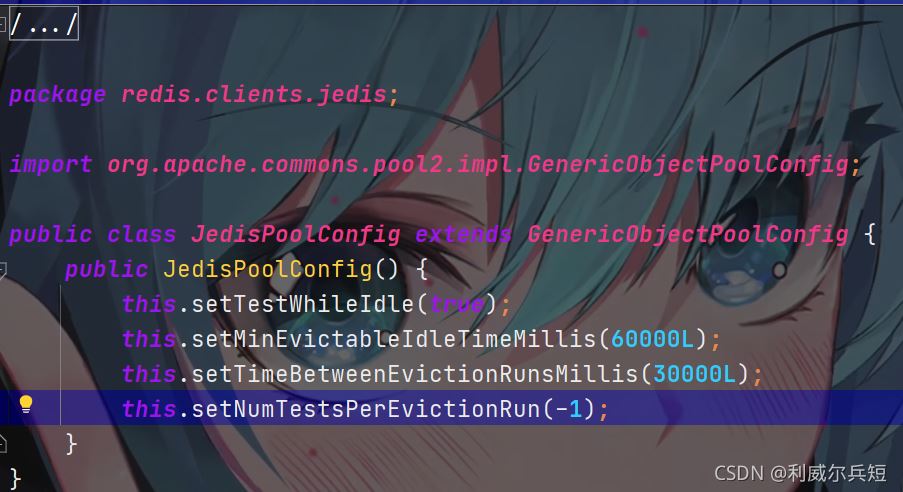
5. 单例模式创建连接池
package com.jt;
import com.jt.redis.JedisDataSource;
import org.junit.Test;
import redis.clients.jedis.Jedis;
import redis.clients.jedis.JedisPool;
import redis.clients.jedis.JedisPoolConfig;
/*享元模式:设计思想,通过池减少对象的创建次数,实现对象的可重用性,所有池的设计都有这个设计模式的应用
* 例如整数池、字符串池、线程池、连接池
* Jedis连接池(与redis数据库的连接)
* AOP 代理模式
* Singleton 单例 HikariPool
* xxxAdapter 适配器模式
* Ribbon 策略
* RestTemplate 模板方法模式
* SL4J 门面
* Interceptor 执行链模式
* 工厂模式
* */
public class JedisPoolTests {
@Test
public void testJedisPool(){
//单例模式创建连接池
Jedis resource = JedisDataSource.getConnection2();
// //定义连接池配置 可不写,有默认的
// JedisPoolConfig config=new JedisPoolConfig();
// //最大连接数
// config.setMaxTotal(1000);
// //最大空闲时间
// config.setMaxIdle(60);
// //创建连接池
// JedisPool jedisPool=new JedisPool(config,"192.168.126.129",6379);
// //从池中获取一个连接
// Jedis resource = jedisPool.getResource();
// 通过redis连接获取数据
resource.set("class", "cgb2107");
String aClass = resource.get("class");
System.out.println(aClass);
//释放资源
resource.close();//把连接还回去
JedisDataSource.getJedisPool().close();
}
}
package com.jt.redis;
import redis.clients.jedis.Jedis;
import redis.clients.jedis.JedisPool;
import redis.clients.jedis.JedisPoolConfig;
/*单例模式创建连接池*/
public class JedisDataSource {
private static volatile JedisPool jedisPool;
private static final String HOST="192.168.126.129";//将来写到配置中心
private static final Integer PORT=6379;
//饿汉式
static {
JedisPoolConfig jedisPoolConfig=new JedisPoolConfig();
jedisPoolConfig.setMaxTotal(16);
jedisPoolConfig.setMaxIdle(60);
jedisPool=new JedisPool(jedisPoolConfig,HOST,PORT);
}
public static Jedis getConnection(){
return jedisPool.getResource();
}
public static JedisPool getJedisPool(){
return jedisPool;
}
//懒汉式
public static Jedis getConnection2(){
if(jedisPool==null){
synchronized (JedisDataSource.class){
if(jedisPool==null){
JedisPoolConfig jedisPoolConfig=new JedisPoolConfig();
jedisPoolConfig.setMaxTotal(16);
jedisPoolConfig.setMaxIdle(60);
jedisPool=new JedisPool(jedisPoolConfig,HOST,PORT);
// return jedisPool.getResource();
}
}
}
return jedisPool.getResource();
}
}
拓展:volatile关键字
- 用来修饰属性、保证缓存一致性,但是不安全
- 1.保证其线程可见性 一个线程改了值,其他线程立刻可见
- 2.不能保证其原子性 不保证线程安全 不保证原子性
- 3.禁止指令重排序(例如count++…)
- 加锁synchronized可以保证原子性
- 在多线程的环境下会出现指令重排序的问题
6. 项目工程实践
6.1 分布式id
在分布式系统中,数据量将越来越大时,就需要对数据进行分表操作,但是,分表后,每个表中的数据都会按自己的节奏进行自增,很有可能出现ID冲突。这时就需要一个单独的机制来负责生成唯一ID,生成出来的ID也可以叫做 分布式ID
package com.jt.redis;
import redis.clients.jedis.Jedis;
import java.util.concurrent.ExecutorService;
import java.util.concurrent.Executors;
public class IdGeneratorDemo1 {
public static Long getId(){
// Jedis jedis=new Jedis("192.168.126.129",6379);
Jedis jedis=JedisDataSource.getConnection();
Long id = jedis.incr("id");
jedis.close();
return id;
}
public static void main(String[] args) {
//构建最多只有3个线程的线程池
ExecutorService es= Executors.newFixedThreadPool(3);
for(int i=1;i<=10;i++){
//从池中取线程执行任务
es.execute(new Runnable() {//这个任务会存储到阻塞式任务队列中 阻塞队列.
@Override
public void run() {
System.out.println(getId());
}
});
}
}
}
6.2 单点登陆
package com.jt.redis;
/*基于reids的单点登录设计和实现
* 1.用户登陆成功后将登录信息存储到redis
* 2.用户携带token访问资源,资源服务器基于token从reidis查询用户信息
* */
import redis.clients.jedis.Jedis;
import java.util.UUID;
public class SSODemo01 {
static String token;
static Object doResource(String token){
//校验token是否为空
if(token==null){
throw new RuntimeException("请先登录");
}
//基于token查询redis数据,假如有对应数据说明用户登录了
Jedis jedis=JedisDataSource.getConnection();
String username = jedis.hget(token,"username");
if(username==null){
throw new RuntimeException("登录超时,请重新登录");
}
String permission = jedis.hget(token,"permission");
jedis.close();
if(!"sys-jedis-create".equals(permission)){
throw new RuntimeException("你没有权限访问");
}
return permission;
}
//执行登录认证、这样的业务写到认证服务器
static String doLoginin(String username,String password){
//1.校验数据的合法性(判定用户名、密码是否为空、密码长度...)
if(username==null||"".equals(username)) {
throw new RuntimeException("请输入用户名");
}
if(password==null||"".equals(password)) {
throw new RuntimeException("请输入密码");
}
//2.基于用户名查询用户信息,并判定密码是否正确
if(!"jack".equals(username)){
throw new RuntimeException("用户不存在");
}
if(!"123456".equals(password)){
throw new RuntimeException("密码不正确");
}
//3.用户存在且密码正确,将用户信息写入到redis
Jedis jedis=JedisDataSource.getConnection();
String token= UUID.randomUUID().toString();
jedis.hset(token,"username",username);
jedis.hset(token,"permission","sys-jedis-create");
jedis.close();
//4.将token信息返回给客户端
return token;
}
public static void main(String[] args) {
//1.登陆操作(用户身份认证)
token = SSODemo01.doLoginin("jack", "123456");
System.out.println(token);
//2.携带token访问资源服务器
Object o = doResource(token);
System.out.println(o);
}
}
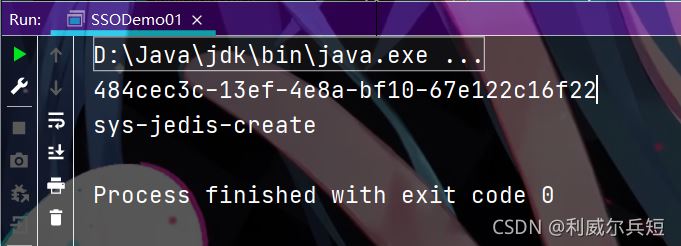
6.3 投票系统
package com.jt.redis;
import redis.clients.jedis.Jedis;
import javax.swing.text.html.HTMLEditorKit;
import java.util.Set;
/*基于某个活动的简易投票系统设计
* 1.投票数据存储到redis(key为活动id,多个用户id的集合)
* 2.一个用户不能执行多次投票
* 3.具体业务操作(投票,获取总票数,检查是否投票过,取消投票,获取哪些人参与了投票)
* */
public class VoteDemo01 {
//指定活动投票总数
static Long getCount(String activiryId ){
//1.建立连接
Jedis jedis=new Jedis("192.168.126.129",6379);
Long scard = jedis.scard(activiryId);
return scard;
}
//获取哪些人参与活动投票
static Object doGetMembers(String activiryId){
//1.建立连接
Jedis jedis=new Jedis("192.168.126.129",6379);
Set<String> smembers = jedis.smembers(activiryId);
return smembers;
}
//投票操作
static void doVote(String activiryId,String userId){
//1.建立连接
Jedis jedis=new Jedis("192.168.126.129",6379);
//2.执行投票
Boolean flag = jedis.sismember(activiryId, userId);
if(flag){
//投票过了再点就取消投票
jedis.srem(activiryId,userId);
System.out.println("取消投票");
}else {
//没投过票
jedis.sadd(activiryId,userId);
System.out.println("投票成功");
}
//3.释放资源
jedis.close();
}
public static void main(String[] args) {
String activiryId="101";
String userId="1";
String userId1="2";
String userId2="3";
doVote(activiryId,userId);
doVote(activiryId,userId1);
doVote(activiryId,userId2);
Long count = getCount(activiryId);
System.out.println(count);
Object o = doGetMembers(activiryId);
System.out.println(o);
}
}
实现效果
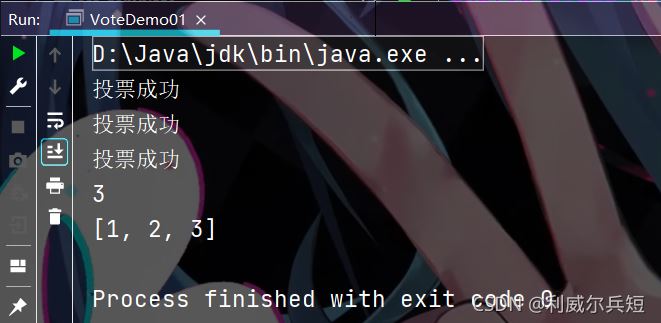
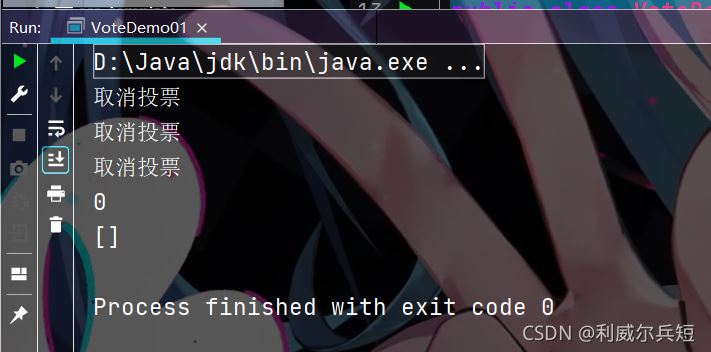
7. StringRedisTemplate 应用
7.1 修改yml文件
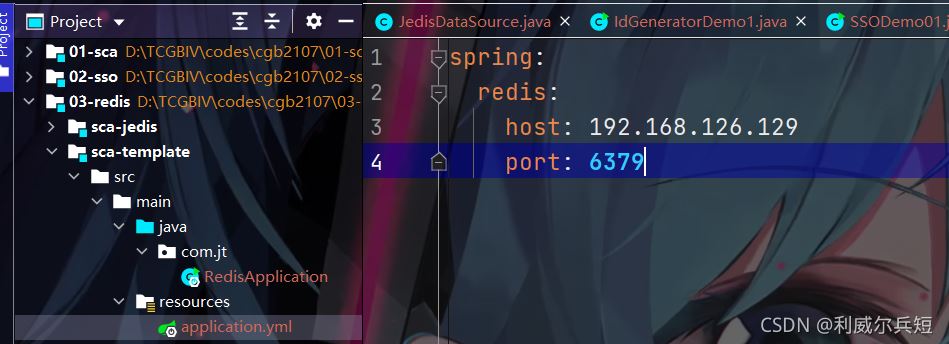
7.2 创建启动类
package com.jt;
import org.junit.jupiter.api.Test;
import org.springframework.beans.factory.annotation.Autowired;
import org.springframework.boot.test.context.SpringBootTest;
import org.springframework.data.redis.connection.RedisConnection;
import org.springframework.data.redis.core.StringRedisTemplate;
@SpringBootTest
public class StringRedisTemplateTests {
@Autowired/*此对象可以实现与redis数据库的交互,存取数据的特点
会以字符串序列化的方式存储key/value
序列化/反序列化
狭义:序列化:1.将对象转化为字节 ;反序列化:将字节转化为对象
广义:序列化:对象→json式字符串或字节 反序列化:将字符串/字节→对象
*/
private StringRedisTemplate redisTemplate;
@Test
void testGetConnection(){
RedisConnection connection = redisTemplate.getConnectionFactory().getConnection();
String ping = connection.ping();
System.out.println(ping);
}
}
==StringRedisTemplate==
此对象可以实现与redis数据库的交互,存取数据的特点
会以字符串序列化的方式存储key/value
序列化/反序列化
狭义:序列化:1.将对象转化为字节 ;反序列化:将字节转化为对象
广义:序列化:对象→json式字符串或字节 反序列化:将字符串/字节→对象
实现效果
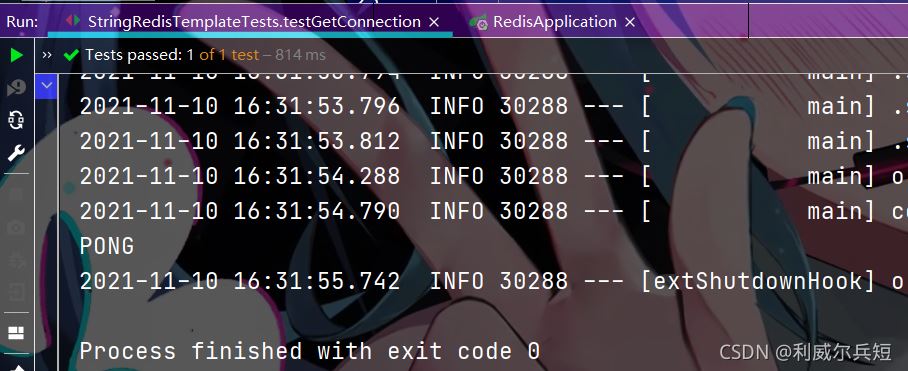
7.3 测试字符串读写
@Test//测试字符串读写
void testString01(){
//获取字符串对象
ValueOperations<String, String> vo = redisTemplate.opsForValue();
//2.读写rerdis数据
vo.set("name", "redis");
vo.set("author", "tony", Duration.ofSeconds(10));
String name = vo.get("name");
System.out.println(name);
String author = vo.get("author");
System.out.println(author);
}
拓展:lettuce
7.4 Hash类型读写
@Test//测试字符串读写
void testHash(){
//获取hash对象
HashOperations<String, Object, Object> vo = redisTemplate.opsForHash();
//2.读写rerdis数据
vo.put("blog", "id", "100");
vo.put("blog", "time", new Date().toString());
Object o = vo.get("blog", "id");
System.out.println(o);
}
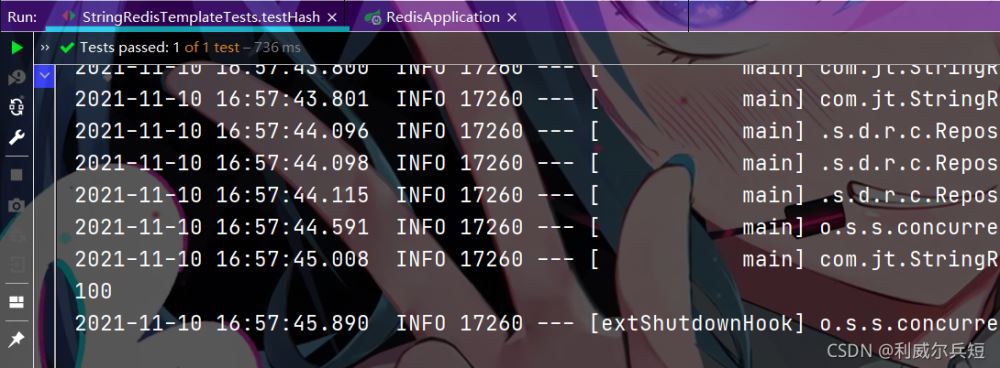
8. RedisTemplate 应用
RedisTemplate是StringRedisTemplate 的父类
默认采用JDK的序列化、反序列化方式存取数据
package com.jt;
import org.junit.jupiter.api.Test;
import org.springframework.beans.factory.annotation.Autowired;
import org.springframework.boot.test.context.SpringBootTest;
import org.springframework.data.redis.core.RedisTemplate;
import org.springframework.data.redis.core.ValueOperations;
import java.time.Duration;
@SpringBootTest
public class RedisTemplateTests {
@Autowired
private RedisTemplate redisTemplate;
@Test
void testString01(){
//1.获取字符串对象
ValueOperations<String, String> vo = redisTemplate.opsForValue();
//2.读写rerdis数据
vo.set("name", "redis");
vo.set("author", "tony", Duration.ofSeconds(10));
String name = vo.get("name");
System.out.println(name);
String author = vo.get("author");
System.out.println(author);
}
}

修改序列化方式
redisTemplate.setKeySerializer(RedisSerializer.string());
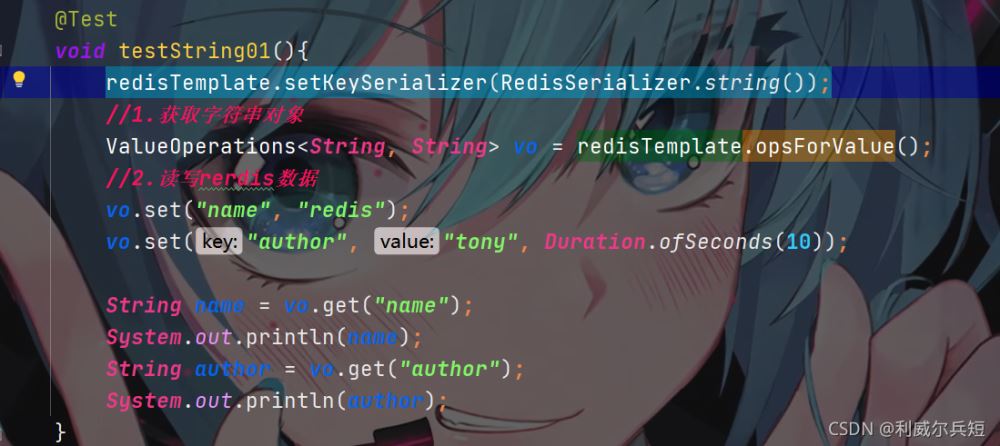
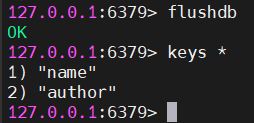
总结
- 为什么使用redis连接池?每次创建连接比较耗时,最好创建后能重复使用
- 连接池设计使用享元模式
- volatile 单线程没必要
加载全部内容